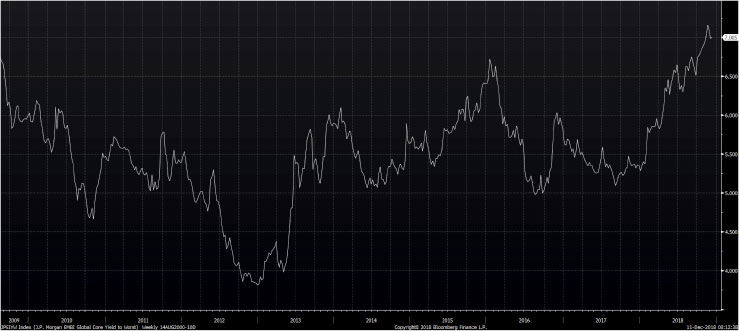Following a challenging year for EM equities, the fundamental outlook for the asset class has begun to exhibit signs of stabilization and selective improvement into 2019, in part driven by a widening growth differential between EM and developed economies. This dynamic characterized the relative outperformance of EM equities during 2016-2017, and was also a contributing factor to the underperformance of the asset class in 2018, as US tax reform, coupled with slowing growth in China and countries facing external vulnerability, exerted downward pressure on EM growth differentials.
Amid this backdrop, attractive carry has again opened up in EM fixed income, as shown in the chart below. While oil acted as a headwind for many EM economies earlier in the year, particularly in an environment in which currency depreciation exacerbated inflationary pressure, this has already begun to recede with the recent collapse in oil prices pointing to slower inflation in the coming year.
Exhibit 1: JP Morgan EMBI Global Core Yield to Worst

Source: Bloomberg
While the 2016-2017 recovery in growth was widespread as EM economies healed from a deep downturn in the preceding years, we may see more dispersion this time around. Several EM economies have adopted a prudent policy mix amid a difficult backdrop, positioning themselves to recover, while others have failed to implement sound policy decisions.
An example of policy dispersion is found in Latin America, where Brazil and Mexico elected new presidents in 2018, with initial indications from the respective administrations pointing to diverging trajectories.
Brazil’s reform agenda following the recent election of Jair Bolsonaro is representative of the type of structural change that is needed in a number of emerging markets. Personal style and social views aside, the far-right Bolsonaro has a genuine opportunity to undertake pension reform and privatizations, addressing Brazil’s fiscal balance in an about-face from the long held populist policies undertaken during previous administrations. Success on this front could accompany a further compression in Brazil’s cost of equity, while bringing about a more sustainable economic recovery following the depression-like conditions felt during the 2014-2015 downturn.
In contrast, Mexico’s President Andres Manuel Lopez Obrador, known as AMLO, has initiated a round of market unfriendly behavior during his initial days in office, threatening to roll back the energy reforms of the prior administration, while creating an unclear outlook for industries such as banking and infrastructure. Most notably, AMLO called for a public referendum on a new Mexico City airport, generating public support to cancel the project, while calling into question the viability of the bonds issued to finance its construction. In the process, this move created a lack of clarity about the future of other infrastructure concessions in the country. Just as equities had begun to recover from the selloff post the referendum, a senior member of AMLO’s Morena party proposed limitations on banking commissions, creating uncertainty over the prospects for fee income growth and the regulatory backdrop in the industry.
These policy maneuvers have pushed up the discount rate on Mexican assets, jeopardizing the country’s growth prospects at a time when other EM economies are showing signs of incremental improvement. We expect this type of macro and policy dispersion to translate into a differentiated opportunity set across EM in the coming year, yielding pronounced winners and losers at the country level.
Other Commentaries
Driehaus Emerging Markets Small Cap Equity Strategy March 2024 Commentary With Attribution
By Chad Cleaver, CFA
Driehaus Emerging Markets Growth Strategy March 2024 Commentary with Attribution
By Howie Schwab